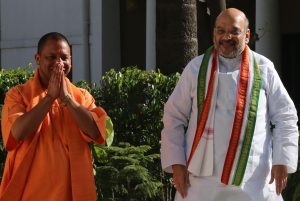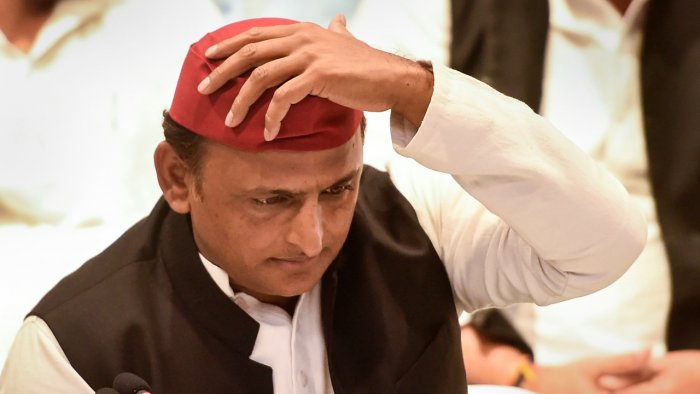

In Western UP, how Muslim votes help swing the fortune of parties

Muslim and Jat voters mainly and others generally are going to play a critical role in the first phase of assembly elections in parts of Western Uttar Pradesh which are slated to go to polls on February 10. Historically, these 58 seats, spread over 11 districts, greatly help in deciding as to who is going to rule over the politically most-important state.
In 2017, the BJP had won a whopping 53 of these seats. This helped the saffron party to catapult to power. Overall the party bagged 312 out of a total of 403 seats in the state Assembly. Before that, in 2012, the Samajwadi Party had captured most of the seats in Western UP. This brought Akhilesh Yadav to power when he was only 38. This is how he remains the youngest among the chief ministers that UP could have thus far.
This time the picture in Western UP may take a few more days to become clearer as fierce electioneering and behind-the-scene manoeuvring is on as the process of filing of nomination papers by the candidates for the first phase that began on January 14 is to conclude on January 27 which is the last date for withdrawal of the papers.

In between this, Union Home Minister Amit Shah is reportedly having hectic parleys with a cross-section of people drawn from the region. There are reports that he called and met prominent people from the Jat community of Western UP through Parvesh Verma, a Jat MP from Delhi and son of former Delhi Chief Minister Sahib Singh Verma. The two leaders are trying hard to build bridges with Jat farmers of the region who virtually fell out with the BJP and NDA during last year’s farmers’ movement against the three farm laws, favouring private sector. The controversial laws have been repealed ever since and Prime Minister Narendra Modi apologised to the farmers in an address to the nation last year. Amit Shah too offered apologies when he met Jat representatives in New Delhi on January 26. He is likely to visit Dadri on Thursday as part of his campaign for votes for his party.
Asked about these moves being made by Shah, the Kisan Union chief Chowdhary Savik Malik told The Federal on Wednesday evening over phone from his Shamli residence, “Nothing is going to cut ice this time for the BJP which is resorting to false propaganda to create a rift among the electorate. Rumours are being spread that only three Jats have been given ticket in the predominantly Jat belt of Meerut, Muzaffarnagar and Baghpat and the rest have gone to Muslim candidates.”
Malik rattled the names of 14 Jat candidates who have been given ticket by the Rashtriya Lok Dal (RLD) and Samajwadi Party (SP) alliance to fight polls in the belt. He pointed out that the SP candidate from Kairana, Nahid Hasan, has been arrested in an old case to keep him off the campaign. “Today I campaigned in solidarity with Nahid’s sister Iqra among Jats of Kairana. Both Hindus and Muslims are not going to be divided this time as was the case in 2017 when false rumours were spread throughout the country about Hindus exodus from Kairana.”
Muslim majority districts
Obviously, the BJP dreads the prospect of Jats and Muslims joining hands to vote together to oust Chief Minister Yogi Adityanath’s government. So let’s have a look at the percentage of Muslim population in the minority strongholds of Western UP.

In Moradabad and Sambal, Muslims constitute 47.12 per cent of the total population; Bijnor has a Muslim population of 43.03 per cent; Saharanpur 41.95 per cent; Muzaffarnagar and Shamli 41.03 per cent; while Amroha has 40.78 per cent Muslims. Five other districts have a Muslim population between 30 per cent and 40 per cent, 12 districts have 20 per cent to 30 per cent Muslims. Five other districts have a sizeable Muslim population too. Technically, any district or assembly seat with at least 20 per cent voter population is considered a predominantly Muslim constituency. Thus, 29 of the 58 seats have Muslim majority which could well prove to be a deciding factor in the first phase of the polls.
Hapur, Muzaffarnagar, Kairana, Aligarh, Ghaziabad and Bulandshahr are likely to witness keen contests. In all these districts, Muslims have a fair share in the population and among the electorate. Yet, the weight of Muslim votes may be lightened because of the presence of multiple candidates from the minority community.
Owaisi’s AIMIM keen to spoil SP-RLD’s party
Of the 58 seats up for grabs in the first phase of the UP elections, Asaduddin Owaisi-led All India Majlis Ittehadul Muslimeen (AIMIM) has fielded 12 candidates, including three Hindus.
The party is placing its bet on Imran Ansari in a triangular contest with SP’s Rafiq Ansari and BSP’s Mohammad Dilshad in Meerut Sadar.
In Dhaulana, near Hapur, the sitting MLA and SP candidate Aslam Choudhary will be up against BSP’s Basid Chaudhary. In 2017, Aslam Chaudhary had won the seat as a BSP candidate.
It is evident that Owaisi is trying to cash in on Muslim majority regions by fielding candidates against BSP and Congress in these two seats. In Charthawal, AIMIM has put Tahir Ansari against BSP’s Salman Saeed and Congress’ Yasin Rana. In Loni, AIMIM’s Dr Mahtab will take on BSP’s Haji Aqeel and Congress’ Yasin Malik. RLD’s Madan Bhaiya and BJP’s Nand Kishore Gujar too are in the fray from Loni. Both Charthawal and Loni have significant Muslim population, but BJP can well hope to benefit from a likely split in Muslim votes as Congress, SP and AIMIM are vying for minority community’s votes.
In Bulandshahr Sadar, BSP’s Mobin Kallu Qureshi is up against SP-RLD’s Haji Yunus. In Kol (Aligarh), BSP has fielded Mohammad Bilal against Salman Saeed of the Samajwadi Party. Here too BJP may take advantage of the split in Muslim votes.
AIMIM’s Taslim Ahmed is likely to give a tough fight to SP-RLD’s Shahid Manzoor in Kithor, near Meerut.
Similarly, Meerapur seat in Muzaffarnagar is likely to see a tough fight between Congress’ Maulana Jameel and BSP’s Mohammad Salim. Last time Jameel had fought on a BSP ticket. In Meerut South, BSP candidate Kunwar Dilshad Ali is pitted against Congress’s Nafees Saifi.
Muslim representation in UP assembly
The community’s representation in the state assembly has seen many ups and downs in the past. Through the decades of the 1960s, 1970s and 1980s amid the intermittent decline of Congress and the rise of socialist parties, the Muslim representation in the House went up substantially. From 6.6 per cent in 1967, it went up to 12 per cent in 1985. In late 80s and early 90s, when the BJP rose to prominence, this representation came down to 5.5 per cent. The era marked the fall in number of Muslims candidates as well. The community rose to prominence again after 1991 and continued to get better representation till 2012, when Muslim nominees won 17 per cent assembly seats. During SP rule under Akhilesh Yadav (2012 to 2017), Muslims had 68 representatives in the House. However, BJP’s clean sweep in 2017 turned things bleak for Muslims. The current assembly has only 23 Muslims representatives.
Jat-Muslim seesaw
Akhilesh Yadav and RLD’s Jayant Chaudhary have been focusing on western UP with an eye on farmers’ discontent. Earlier, both the leaders openly spoke for farmers, demanding repeal of farm laws. Now the SP is trying to woo the peasants by promising a memorial at a cost of ₹25 lakh in honour of those who lost their lives during the year-long protests at Delhi’s borders. The two parties are banking on Jat-Muslim amity which was destroyed during 2013 Muzaffarnagar riots.
Indeed, the SP and RLD are walking a tightrope. Both the parties are taking special care to ward of any polarisation of votes on communal lines. If they succeed in doing so, the alliance should be able to make a big dent in BJP’s fortunes from Baghpat to Muzaffarnagar.
Can SP win back Muslim-majority seats?
In 2012, the Samajwadi Party had bagged nearly 50 per cent of the 57 seats in UP that have a predominant Muslim population. Five years later the BJP swept 37 of these 57 seats, which helped them capture power. While the SP managed to win only 17 seats in places where Muslims had a little edge, its vote share increased from 25.8 per cent in 2012 to 29.6 per cent in 2017. The BJP’s share during this period went up from 21.6 per cent to a phenomenal 38.8 per cent. It is quite evident that the BJP and SP grew at the expense of Mayawati-led Bahujan Samaj Party and Congress that got severely marginalised in 2017.
A long-time observer of UP politics sums up the Muslims mood this time by saying, “Largely, Muslims, or say about 80 per cent of them, are now converging towards RLD-SP alliance as realisation among them is growing that AIMIM is a spoiler though Congress can well get about 15 odd percent of Muslim votes.”
Impact of farmers’ agitation
The 11 districts of Western Uttar Pradesh going to polls first in the seven phased elections were actually the hotbed of farmers’ agitation. Samyukt Kisan Morcha (SKM) leader Rakesh Tikait came to have a sway over the region through the protests. While SKM has decided not to contest polls, Tikait’s tirade against Prime Minister Narendra Modi and BJP right from the days of the anti-farm law stir is likely to have a bearing on BJP’s fortunes in the region.
The BJP not only has to prepare well to face angry farmers, but also needs to sustain the polarisation of the past through the Muslim strongholds. The BJP expects to draw benefit from the alleged Hindu migration controversy in Kairana although this is now a nearly six-year old tussle. Recently, Union Home Minister Amit Shah visited Kairana and met families affected by the alleged exodus from the region. Here, BJP candidate Mriganka Singh is pitted against SP’s Nahid Hasan.
The political scene of Muzaffarnagar too has changed after the communal riots of 2013. The result of every election since then, or right from 2014 to 2017 to 2019 has been affected by the faith-based polarisation caused by the riots.
But as of now, about 50 per cent Jats appear to be inclined to support Muslim candidates of the RLD-SP alliance, says the observer cited earlier. As per him, through the past few days, the BJP has stepped up its bid to win over Jat voters. Unlike Jats, Gujjars are 80 per cent with BJP except where the alliance has given ticket to Gujjar candidates. BSP is quite weak and its vote can well shift to BJP.
In terms of numbers, the observer gives 23 seats to the alliance while the BJP may get up to 30 seats in the first phase from a total of 58 seats. And the rest of the five seats could well go to Congress. The BSP may well draw a blank or snatch away one or two seats from Congress. This assessment, he warns, is as per the situation now which may well evolve and change as electioneering picks up further through the days to come.
Also read: RPN Singh is no mass leader but his exit exposes Congress’ mess, again
The SP and Congress fought in alliance against the BJP, but this time the Rashtriya Lok Dal (RLD) is in alliance with the SP while Congress is fighting alone.
In 2017 assembly polls, the BJP had won 312 out of 403 seats in Uttar Pradesh. The Samajwadi Party and the Congress had formed an alliance with the former contesting on 298 seats and the latter on the remaining 105 seats. The SP could manage to win only 47 seats and Congress got seven seats. Bahujan Samajwadi Party (BSP) had won 19 seats.


